Raising Water Consciousness through
World’s Biggest Photo Exhibition and
Largest collection of Photo Stories on Water
Photo Stories | Drinking Water A story based on the theme of World Water Day 2018
Nature-based Solutions for Drinking Water: Sustainability in Simplicity
Nandita Singh and Om Prakash Singh
15 June, 2018

Drinking water in India is increasingly facing challenges in terms of quality as well as quantity as elucidated in a number of previous stories. This is true in case of both surface- and groundwater and affects rural as well as urban areas. According to the Central Groundwater Board (CGWB), over 28% of development blocks (local administrative units) are in an 'Over-exploited', 'Critical' or 'Semi-Critical' state because groundwater development (i.e., the ratio of annual groundwater draft to net annual groundwater availability) is more than 100%, 90-100% or 70-90% respectively. Also, CGWB assessments show serious groundwater quality degradation due to fluoride, arsenic, iron, salinity, lead, cadmium, chromium, nitrate, persistent organic pollutants (POPs) and other contaminants. According to the Central Pollution Control Board (CPCB), surface water quality is also getting increasingly degraded with 275 rivers reporting highly polluted stretches. With about 90% of drinking water supplies in the country derived from groundwater and the rest from surface water, this situation calls for robust and sustainable solutions. Some of the solutions already implemented in the country have been illustrated in previous stories, but in most cases questions of sustainability loom large. It is nature that provides water for human use by producing, augmenting and safeguarding it through the 'water cycle', as amply illustrated in the story dated 22 March 2018. The basis of the water cycle is rainfall which is the purest form of water on Earth. Using simple technologies, this rainwater can be directly collected or allowed to percolate into the ground to re-appear as springs or be extracted through wells and handpumps. The water from springs or recharged groundwater can even be supplied through piped water systems. India receives an annual precipitation of the order of 4,000 billion cubic meters. This provides the opportunity of benefitting directly from nature-based solutions in terms of both quantity and quality challenges. This story aims to present a selection of nature-based solutions for drinking water in practice in different parts of the country. Though the distribution of monsoon rain in India is not even across the land, simple technologies based on rainwater harvesting have shown the potential of sustainably and safely quenching people's thirst even in the driest place of the country – the Thar Desert. The title photo depicts a 'kund' - a large underground tank that stores rainwater harvested from its catchment - in use in Bikaner district, Rajasthan. Kunds serve to supply drinking water especially during the lean season and can have capacities of 1,000 liters or more. A smaller kund is known as 'kundi' while in Jaisalmer district kund and kundi are called 'tanka'.
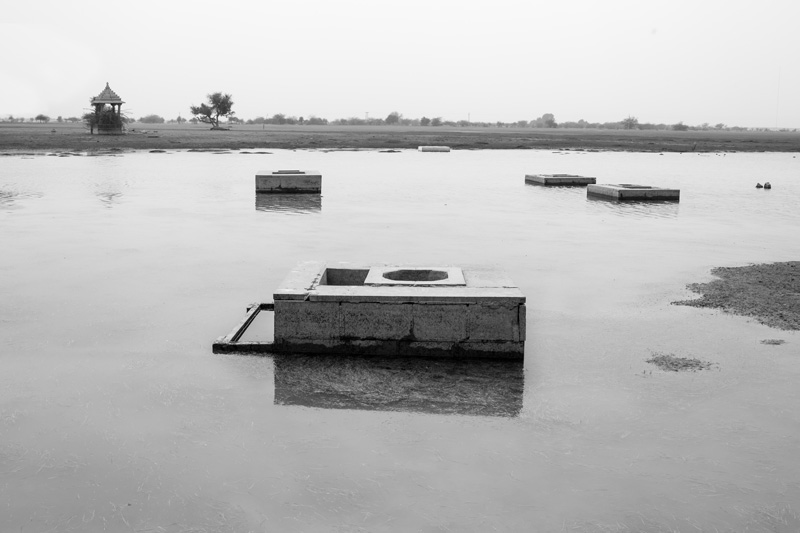
A rainfed pond having shallow wells inside, used for drinking water supply round the year in the arid Thar Desert in Jaisalmer district, Rajasthan
Availability of ‘sweet’ drinking water is a significant challenge in the arid and semi-arid regions of India. Rajasthan is an important example where rainfall as well as surface and groundwater resources are limited. The average annual rainfall in Jaisalmer district, which lies in the heart of Thar Desert, is less than 210 mm, and within the district, the lowest rainfall area is Ramgarh where the figure reaches barely 100 mm. Moreover, groundwater which is extracted through deep wells is highly saline and streams are rare. Thus, rainwater is a very precious resource, every drop of which is collected and carefully preserved primarily for drinking purposes. Villages here are dependent upon local catchments that allow the runoff to be collected in ponds. This collected runoff may be fetched by women directly as drinking water and by acting as a percolation tank, it ultimately helps recharge shallow aquifers that later supply drinking water through shallow wells. The photo above depicts Viprasar – a rainfed pond with a catchment spread over 25-30 km. This pond gets filled with just about 30 mm rainfall received during barely 1-3 days in a year. The pond water is directly collected by village women and girls for drinking, and its base serves as a recharge zone (called ‘taanda’) for 23 shallow wells (called ‘beris’) located inside it. During the lean season, and also during the years of poor rainfall, the beris which are up to 5-15 m deep, serve as the drinking water sources for the village.
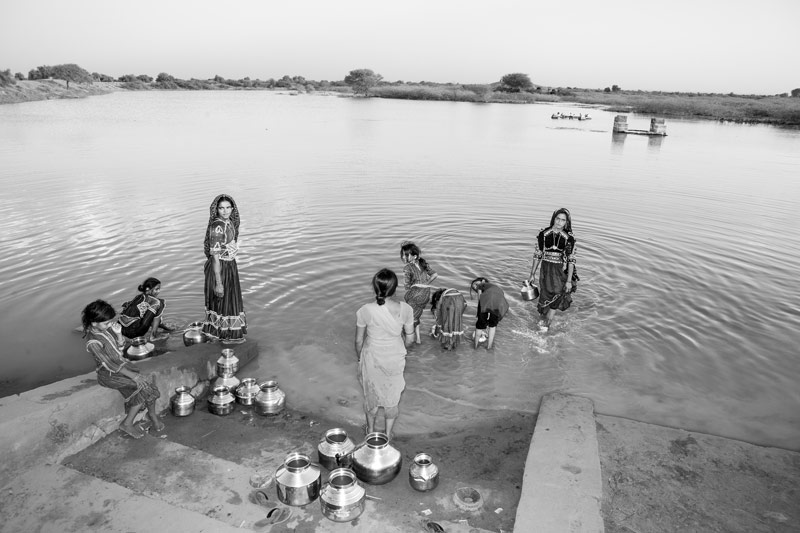
A drinking water pond in use for collecting ‘sweet’ and 'safe' drinking water in Kutch district, Gujarat
Apart from salinity, high fluoride content in groundwater is also a significant concern in a number of areas in India. In the semi-arid Kutch region of western Gujarat, groundwater suffers from salinity as well as fluoride contamination which pose a challenge to women and girls in procuring drinking water that is ‘safe’ and of an ‘acceptable’ quality. Similar problems are reported from other districts like Mehsana and Patan in northern Gujarat. A sustainable solution to the problem, practiced since centuries, lies in rainfed ponds with wells inside that are used as drinking water sources in the villages. The surface water from the ponds is first directly used as drinking water, after which the wells located inside the pond are put to use during the lean season. One such pond in use as a drinking water source, with two submerged wells, is shown in the above photo. For upkeeping quality of the pond water, community rules are laid down such as keeping footwear and animals away, which are strictly followed.
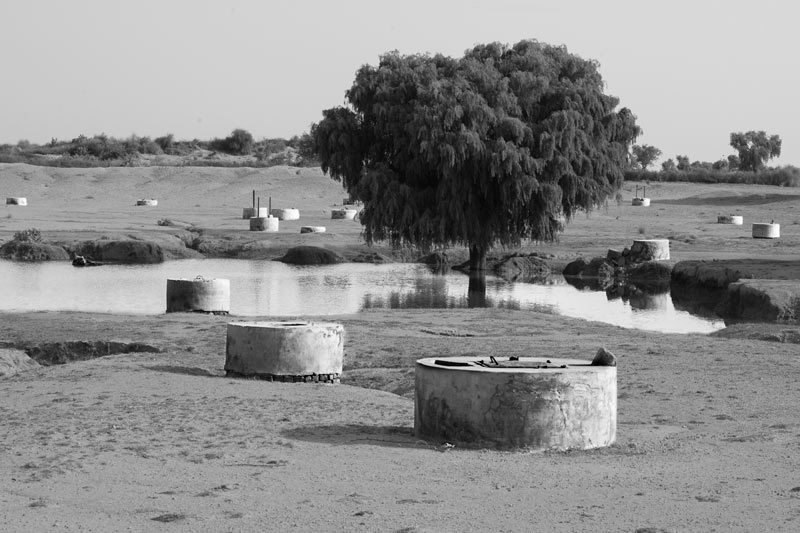
A rainfed pond (‘johad’) along with a cluster of shallow drinking water wells (‘kuiyan’) in its catchment in Bikaner district, Rajasthan
In Bikaner district, the average annual rainfall is only 240 mm, but when carefully harvested, this scanty rainfall ensures drinking water supply in the villages round the year. This is done through village catchments, locally known as ‘paaytan’, which are cleaned every year before the onset of monsoon and strict social rules are followed about its usage by the community. Rainfed ponds located in the village catchment are called ‘johad’ that serve to recharge the shallow aquifer around. In this recharge area, called ‘taada’, shallow drinking water wells called ‘kuiyan’ are dug. The water of the johad shown in the above photograph is not used directly for human consumption but allowed to be filtered through the soil layers into the shallow kuiyan from where clean and safe drinking water is withdrawn by the villagers. The johad which is about 400 years old, has 100-150 kuiyans in its vicinity, of which about 50 are presently in use. The water supplied by these kuiyans suffices the drinking water needs of the entire village consisting of about 400 households.
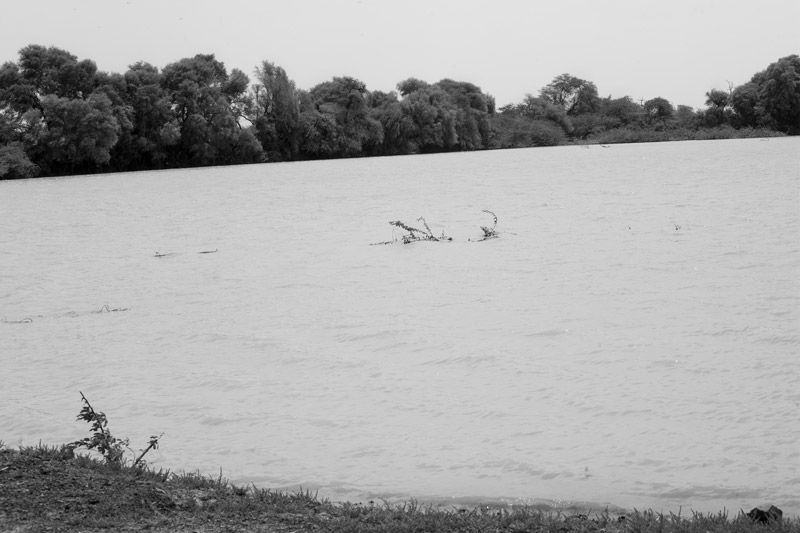
An agricultural ‘khadin’ that serves to recharge an adjacent shallow drinking water well in Jaisalmer district, Rajasthan
Drinking water sources based on rainwater harvesting may also be recharged by agricultural water sources. In the arid Thar Desert, the ‘khadin’ is a large saucer-shaped agricultural area located on the lower side of a catchment that holds rainwater for enabling agriculture in the winter season. Moisture captured in the deeper soil layers enables production of rabi (winter) crops like wheat, mustard and black gram without external irrigation. By holding rainwater over a period of 1-2 months, the khadin also serves as percolation tank that enables recharge of shallow aquifers located underneath and nearby. Thus in some villages, recharge areas (taanda) are located adjacent to the khadin embankment with shallow wells (beris) dug inside which provide sweet drinking water to the villagers. The khadin shown in the above photo serves this important function.
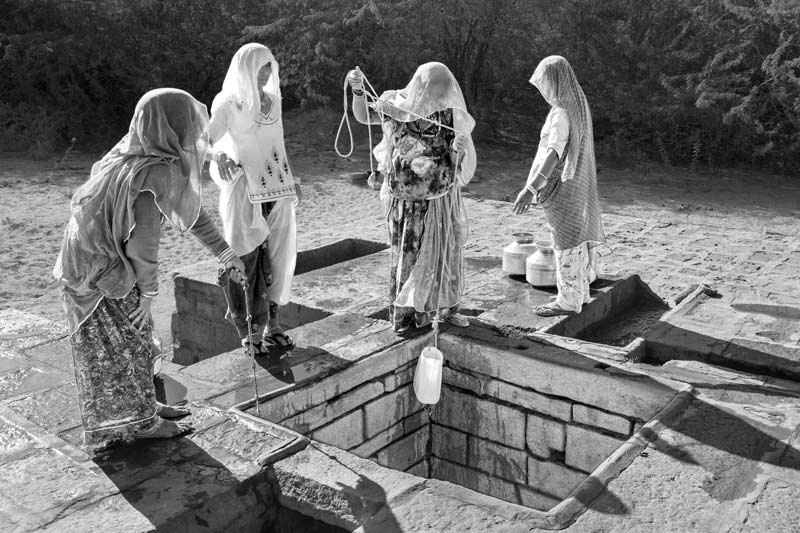
A shallow well (beri) recharged by an adjacent khadin used by women for procuring drinking water in Jaisalmer district, Rajasthan
The khadin shown in the previous photo helps recharge of an adjacent beri that is shown in the above photo. This beri is the only source of ‘safe’ drinking water in a village inhabited by 315 families. Here the groundwater is not only saline but also rich in fluoride. A piped water supply scheme exists in the village but this is based on groundwater. As a consequence of long-term consumption of fluoride-rich piped water, a number of villagers, especially women and children, have come to suffer from symptoms of fluorosis. In the wake of the emerging health concerns, the once abandoned traditional beri has come to be rejuvenated by the villagers and brought back to regular use by women for procuring drinking water.
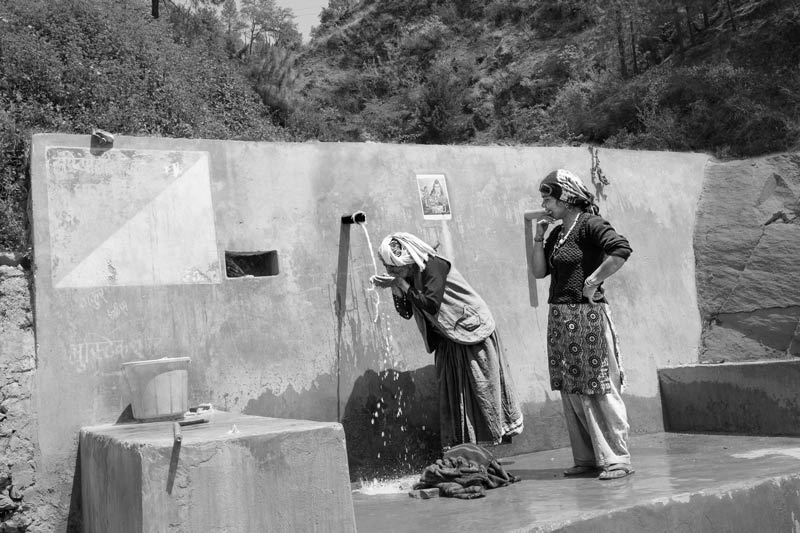
A protected spring providing drinking water in Uttarkashi district, Uttarakhand
Springs occur where groundwater intersects the surface and these serve as an important nature-based water source in India providing safe, perennial drinking water. Five million springs are estimated to support hill and mountain communities, with nearly 200 million people depending upon their water across what can be called the ‘springscapes’ of India. The latter mainly comprise the Himalayas, Western Ghats, Eastern Ghats, Aravallis and other smaller mountain ranges. In Uttarakhand, where 11 out of 13 districts are mountainous, more than 260,000 springs are known to serve as drinking water sources, being the basis of over 90% of the drinking water systems. The springs in Uttarakhand are fed by meltwater from snow in the upper reaches of the Himalayas as well as rains downstream. In Uttarkashi district, where spring-based drinking water sources are locally called ‘gadera’, these are made user-friendly by fitting a pipe in the fracture of the rocky wall through which they emerge. In some places springheads have been more systematically protected from pollution by constructing a spring protection box from which water is allowed to flow out through a metal pipe placed at a suitable height so that it can fall with gravity directly into a container. One such protected gadera is shown in the above photo.
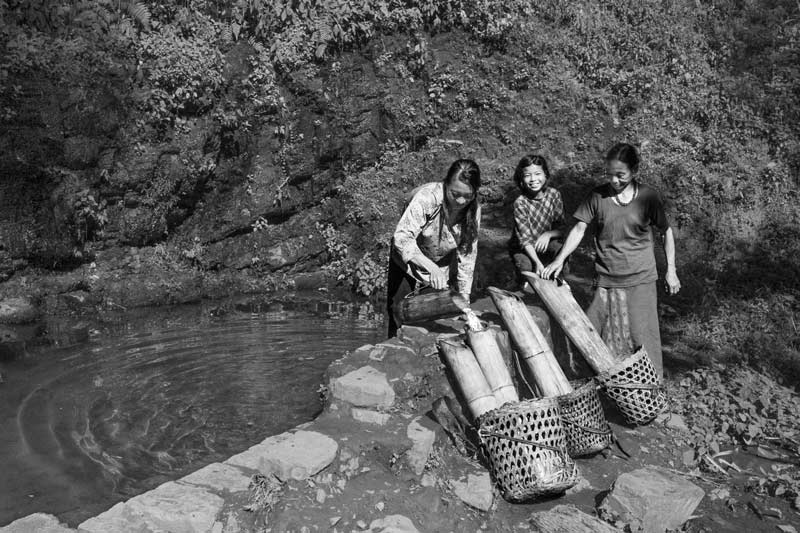
A spring-fed tank in use for drinking water collection in Kohima district, Nagaland
In North-Eastern India, more than one-fourth of the rural habitations are dependent upon springs as drinking water sources. In Nagaland, which is mostly mountainous, springs play a major role in fulfilling the drinking water needs of rural as well as urban populations. About 45% of the villages depend upon springs as major water source. Naga villages are generally located on hill tops where local springs provide water for drinking and other domestic uses for a few months after the monsoon. Larger number of springs are located in the foothills and intermontane valleys that provide water for longer periods. In a number of places, spring-fed tanks have been created where the discharge from the spring slowly collects from where women, men and children can collect drinking water. One such spring-fed tank used especially during the dry season is shown in the photo above.
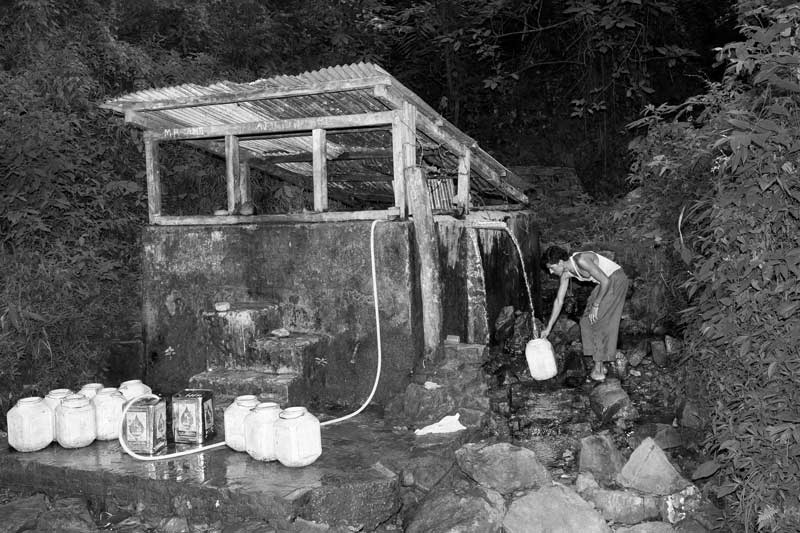
A protected spring-based tank in Kohima district, Nagaland
For water quality protection and for improving spring sustainability, in some villages of Nagaland the springs supplying drinking water to the local communities have been protected. The discharge from the protected spring shown in the above photo collects in a closed tank from where it is collected into containers using pipes.
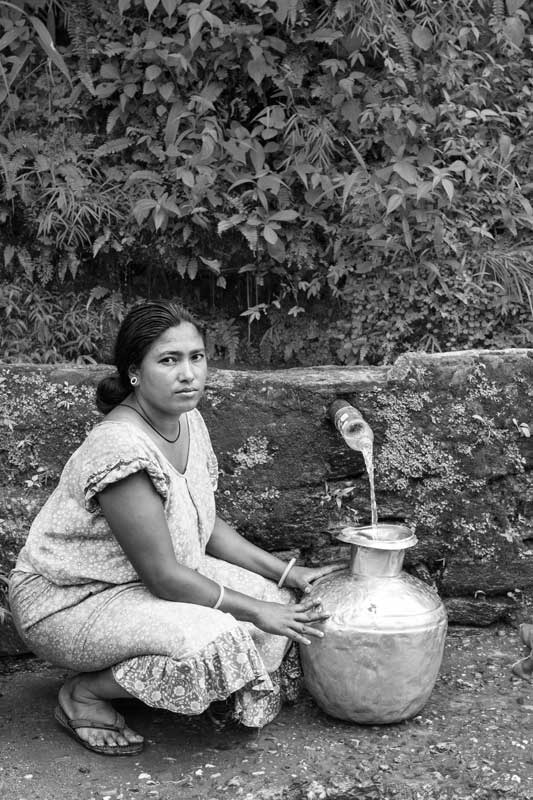
A hill spring serving as an improvised drinking water source in Darjeeling district, West Bengal
Darjeeling is the only hill district of West Bengal and here more than 32% of the rural communities are known to be dependent on springs. These springs, locally known as 'jhoras' are an important source of drinking water in the district. Even urban communities depend upon spring sources, with Darjeeling town itself being supplied drinking water by 26 springs. Many small springs get recharged during the monsoon season and continue to produce water for some months after. These are conveniently made use of for drinking water collection through small improvisations, such as the one shown in the photo above.
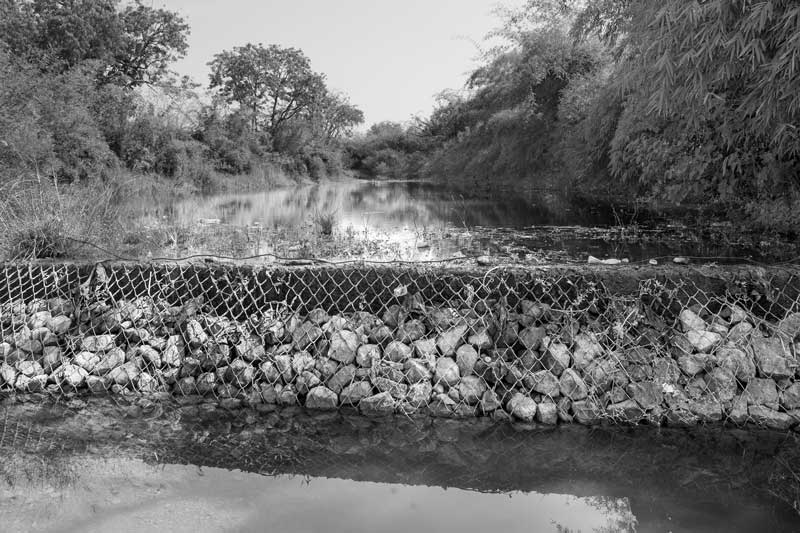
A ‘gabion’ as a ‘nala’ (drain) bund helping in water conservation and groundwater recharge in Ahmednagar district, Maharashtra
A holistic, nature-based approach that can help conserve, rejuvenate and augment ground- as well as surface water resources at the local scale is ‘watershed management’. In this approach, a ‘watershed’, which is an area draining the rainwater into a stream, is developed and protected through integrated use of its natural resources, namely, water, land and the green cover. For this purpose, different kinds of structures such as check dams, gabions, loose boulder structures, contour trenches, contour bunds, etc. are constructed at appropriate places within the watershed. Also, afforestation is carried out. These activities help in water and soil conservation and increasing the water-holding capacity of land, in turn helping in rainwater harvesting as well as groundwater recharge. In addition, dams and percolation tanks may be constructed to locally store the runoff received within the watershed and aid groundwater recharge. Watershed management has been the secret of poverty alleviation and integrated development in village Ralegan Siddhi under the leadership of Anna Hazare. One of the watershed structures called ‘gabion’ constructed in the village is shown in the photo above. A gabion consists of stones wrapped in a steel wire mesh and here it has been placed as a ‘nala bund’ in the local drain that brings rainwater from the hillslopes towards the village downstream. The gabion primarily helps in water conservation by checking the water flow, further also facilitating groundwater recharge.
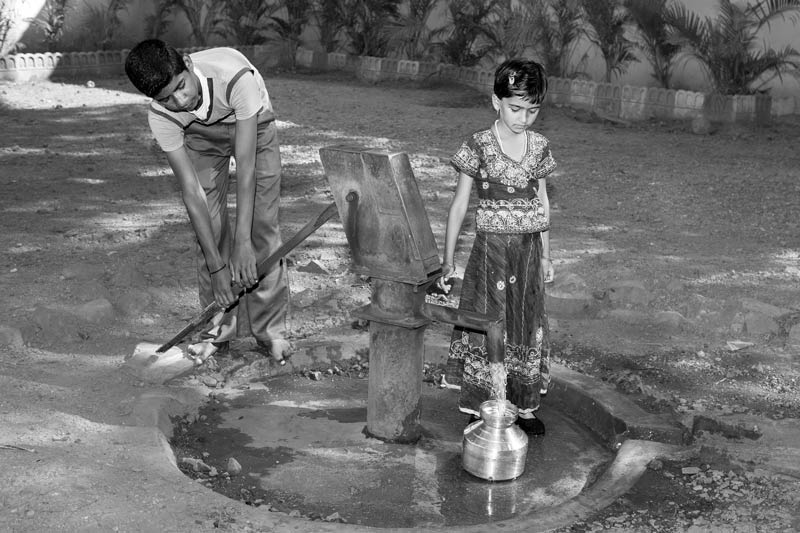
A handpump recharged through watershed management in Ahmednagar district, Maharashtra
The different kinds of structures constructed in a watershed help in water conservation and groundwater recharge, enhancing the water table, thereby facilitating drinking water availability to communities. In Ralegan Siddhi, at one time, groundwater used to be available at depths greater than 400 meters, but because of different watershed activities, including the one shown in the previous photo, groundwater is now readily visible in the wells at an easily accessible depth, and handpumps supply water round the year. One of these handpumps is shown in the above photo.
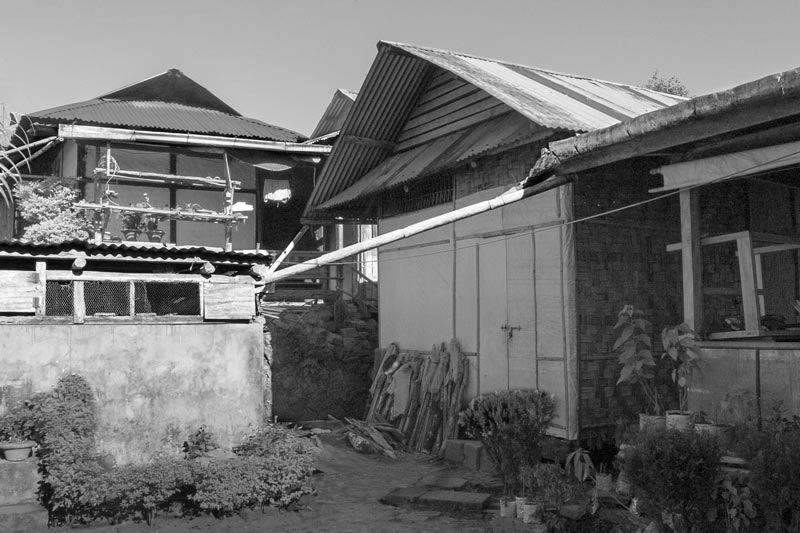
Rooftop rainwater harvesting in Mokokchung district, Nagaland
While watershed management is essentially based upon harvesting the rain available in a watershed, an effective method of augmenting household-level water availability is rooftop rainwater harvesting. This involves collecting whole or part of the rainwater that falls on the roof of a house and storing it for later use or else diverting it for recharging the groundwater. Rooftop rainwater harvesting can help meet a substantial part of the drinking water requirements of a household. Its use for recharging groundwater is also a common practice, which can later be extracted for domestic use. The average annual rainfall in Nagaland and the rest of the North-East is quite high, being above 1,000 mm, with the hilly areas receiving 2,000–3,000 mm. About 90 % of the rain is received during the southwest monsoon. Given this magnitude and intensity, rooftop rainwater harvesting is an effective nature-based solution in the region for enhancing drinking water availability. In the above photo, rooftop rainwater harvesting is being used in a residential building for augmenting drinking water reserves for the household. In fact, rooftop rainwater harvesting is a good solution for augmenting drinking water availability in all parts of the country, in rural and urban communities, and many States as well as metropolises have already adopted policies making rooftop rainwater harvesting mandatory for new buildings.

Tanks used for collecting the rainwater harvested from the rooftop shown before in Mokokchung district, Nagaland
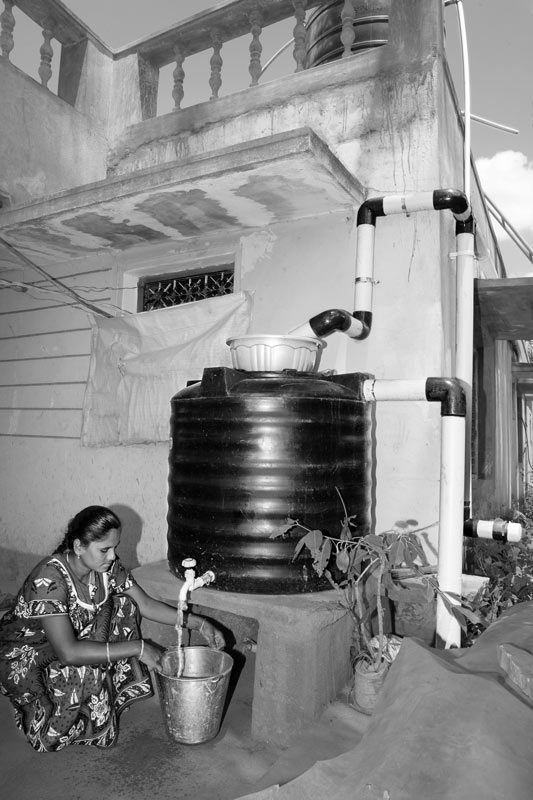
Rainwater harvested from the roof being withdrawn for drinking and cooking purposes in Chikkaballapur district, Karnataka
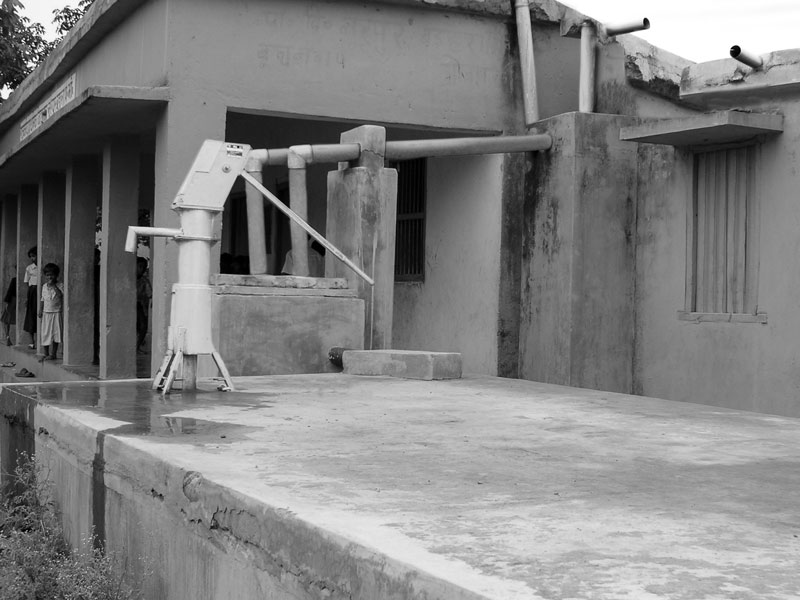
Rooftop rainwater harvesting for arsenic mitigation in Bhojpur district, Bihar
In addition to being a solution for addressing the problem of water shortage, rooftop rainwater harvesting is also an excellent solution for ensuring ‘safe’ drinking water in quality-affected areas. According to statistics from the CGWB, groundwater in 20 states is affected by high fluoride, in 8 states by high levels of arsenic, and in 10 states by inland salinity, besides iron and nitrate as common problems. In Bihar, arsenic contamination in groundwater is reported from 18 districts, exposing more than 10 million people to the threat of arsenicosis which leads to cancer and ultimately death. Bihar receives more than 1,100 mm average annual rainfall, a substantial part of which can be harvested from rooftops to mitigate arsenic as is being done in a rural school as shown in the above photo.
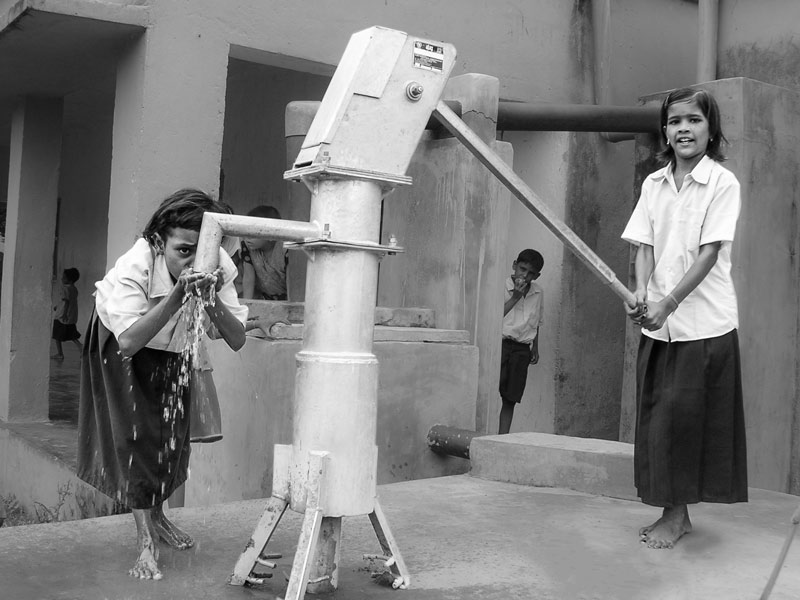
Rainwater harvested from the rooftop being used as drinking water in a school in Bhojpur district, Bihar
Since rainwater is the most pure form of water, if properly managed with considerable attention to cleanliness and hygiene, rooftop rainwater harvesting can directly yield safe drinking water in areas having contaminated water sources. Though a number of technological options exist which help in mitigating contamination caused by arsenic, fluoride, salinity etc., such as through treatment of contaminated water and piped water supply from rivers, each of these options faces limitations, questioning their sustainability. However, since rainwater is easily accessible, and can be collected, stored and used through simple technologies, rainwater harvesting in general, and rooftop rainwater harvesting in particular, can be argued to be more sustainable. In the photo above, rainwater is collected from the rooftop of the school in a large tank, on which a handpump has been installed to help withdraw the water without causing any risk of microbial or other kinds of contamination.
This story has presented glimpses of nature-based solutions for drinking water practiced in different parts of India. These solutions are basically dependent upon the ‘water cycle’ in nature, which provide communities with adequate supplies of drinking water that is safe and also easy to access through simple technologies. Rainwater harvesting - the technique of collecting, storing and using rainwater in different forms - is the most common cross-cutting principle, followed by tapping of naturally occurring or recharged groundwater. The nature-based solutions discussed in the story are functionally adaptive to local geographies, climates, hydrology, as well as the resources and skills base of the community and rooted in the principle of ‘balance with nature’. Moreover, being commonly derived from traditional knowledge, these are time-tested, and thereby robust and reliable. Being simple, these are also often gender-sensitive - user-friendly particularly for women who are the major group concerned with collection, transport and management of drinking water. Many of the solutions presented in the story have been practiced in India through ages. While some of these continue to be traditionally in use, some others have been recently rejuvenated or redesigned in quest of sustainable solutions to the growing quality and quantity challenges to drinking water in the country. Rooftop rainwater harvesting is an example of redesigning of rainwater harvesting to particularly suit urban contexts. Some interventions from the government have adopted nature-based principles in relation to water, such as the watershed development program and urban rainwater harvesting, but a clear connection between these initiatives and drinking water security is not yet drawn. The current national policy framework on rural drinking water supply mentions the principle of “conjunctive use of ground water, surface water and rainwater” and includes rainwater harvesting and groundwater recharge as steps in this direction. However, in terms of practical action, the focus continues to remain on piped water supply based on either distant surface water sources or groundwater. Even handpumps based on receding water tables continue to be in focus. While dependence on distant water sources brings many limitations, action for recharging the groundwater that feeds piped water systems and handpumps is largely missing. Successful rainwater harvesting and watershed development projects are presently at best implemented by non-governmental oraginisations (NGOs) and individual rural community leaders, and these are countable few. Even the springshed development initiative is yet to take an official shape, and exists only as dispersed NGO projects. Rainwater harvesting as a mitigation approach for addressing water quality problem exists no more than demonstration projects. Given the merits of the nature-based solutions noted above, there is no doubt that these offer a highly sustainable way forward to meeting the drinking water needs in the country. These can enable women, men and children the possibility to enjoy their human right to water even in an era of stress on water resources due to various climatic and non-climatic drivers. It is therefore imperative that for enhancing drinking water security in local communities, there is an urgent need to systematically incorporate various nature-based solutions into national policy, programs and projects, and ensure their effective implementation. This alone would enable progress of the country towards sustainable development. In particular, the Sustainable Development Goals (SDGs) concerning 'clean water and sanitation', 'good health and well-being', 'gender equality', 'quality education' and 'climate action' would get immensely supported.